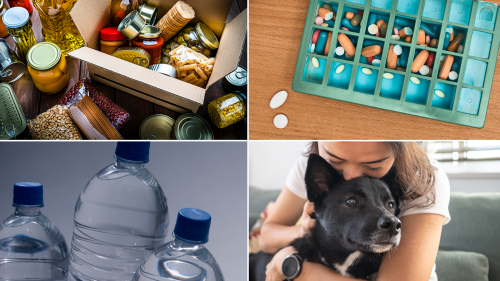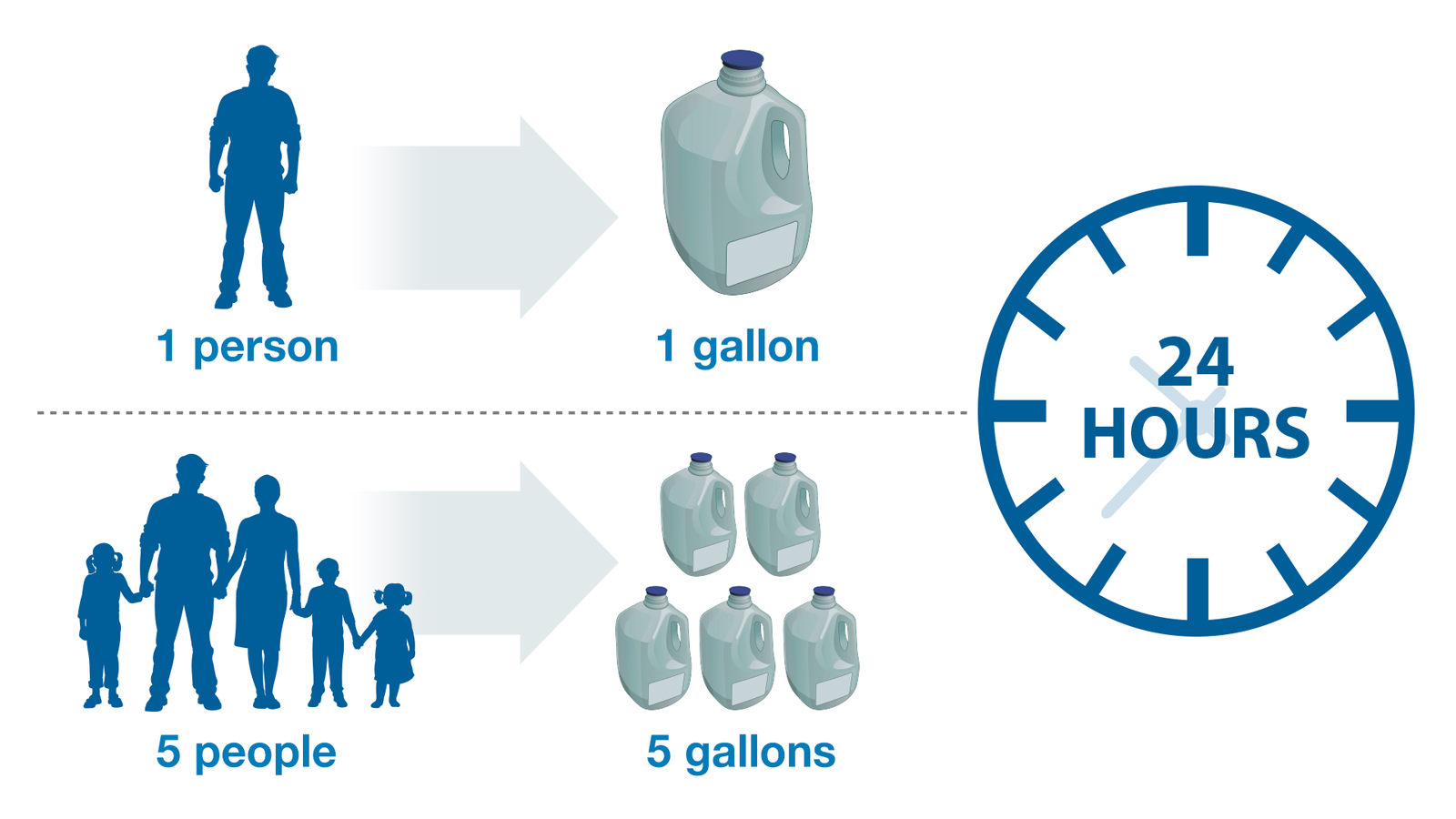Hurricane Season: Be Prepared
Although the six-month hurricane season officially begins on June 1, storms have formed in May, several times in recent years. It's important to safeguard your food, water, medicine and pets before, during and after any severe weather event.

When gale-force winds start blowing and torrential rains raise water levels, you need to be ready.
Power outages mean refrigerated food and medicine supplies may spoil. Floods may contaminate tap water and emergency supplies not stored properly with sewage, chemicals, heavy metals, pathogenic microorganisms, or other contaminants.
If the storm or flood is severe enough, you may need to evacuate with little time to prepare. Don’t put off being prepared until the emergency hits.
Keeping Food and Water Safe
Consumers, especially in storm-prone areas, should maintain an emergency kit stocked with non-perishable food, extra medication and hygiene supplies. Here are some food-related tips to remember:
- Do not eat any food that is not in a waterproof container if there is any chance it came in contact with flood water.
- Inspect canned foods and discard any food in damaged cans. Damaged cans may have swelling, leakage, punctures, holes, or rusting.
- Do not eat food packed in plastic, paper, cardboard, cloth and similar containers that have been water-damaged.
- Discard food and beverage containers with screw-caps, snap lids, crimped caps (soda bottles), twist caps, flip tops and home canned foods, if they have come in contact with flood water. These containers cannot be disinfected.
- Follow tips on how to keep food safe at proper temperatures.
- Discard any perishable food (such as meat, poultry, fish, milk, eggs or leftovers) that has been held at room temperature for 2 hours or more (or 1 hour if outdoor temperatures are above 90º F).
Food safety doesn’t stop with inspecting the packaging. It also involves what comes in contact with the food after you open it:
- Thoroughly wash pots, pans, ceramic dishes, and utensils (including can openers) with soap and water, using hot water if available. Rinse and then sanitize them by boiling in clean water or immersing them for 15 minutes in a solution of 1 tablespoon of unscented household (5.25% concentration) liquid bleach per gallon of water.
- Thoroughly wash countertops with soap and water, using hot water if available. Rinse and then sanitize by applying a solution of 1 tablespoon of unscented household (5.25% concentration) liquid bleach per gallon of water. Allow to air dry.
Water Storage: How Much is Enough?

Access to clean water is essential. The Federal Emergency Management Agency, Red Cross and Centers for Disease Control and Prevention recommend a minimum of one gallon of water per day for each member of the family. Store at least a 3-day supply of water for each person. However, a 2-week supply is better if you have the space.
Food Safety During Power Outages
Power loss is common in severe storms, but there are ways to increase the time the food in your fridge will remain safe to eat. It’s important to keep the refrigerator and freezer doors closed. Food in an unopened refrigerator is safe to consume if the power outage lasts less than 4 hours. The foods in the freezer are typically safe for 48 hours if it is full or 24 hours if the freezer is half full.
For refrigerated items, after the 4-hour power outage, it is best to pack them into a cooler surrounded by ice or frozen gel packs for storage. Check the food temperature of these items before cooking or eating them and toss them out if the item has been above 40 degrees Fahrenheit for two hours or more.
For infants, ready-to-feed formula should be used. However, if only concentrated or powdered formula is available, prepare the formula with bottled water or water that has been sterilized. Your doctor or public health authorities can advise if water needs to be boiled before use. You should ensure that the bottles and nipples used are also sanitized.
To keep your drinking water safe:
- Use bottled water that has not been exposed to flood waters if it is available. If you don't have bottled water, you should boil water for one minute. This will kill most types of disease-causing organisms, such as cholera, typhoid, salmonella, giardia, E. coli, and amoebas. Let the boiled water cool and store it in clean containers with covers.
- If you can't boil water, you can disinfect it for drinking or other use by adding 1/8 teaspoon (or 8 drops) of regular, unscented, liquid household bleach per gallon of water. Stir it well and let it stand for at least 30 minutes before using it.
- If the water is cloudy, filter it through layers of clean cloth or allow it to settle, then draw off the clear water for disinfection.
- If you have a well that has been flooded, the water should be tested and disinfected after flood waters recede. If you suspect that a well may be contaminated, contact your local or state health department or agriculture extension agent for specific advice.
For more information on keeping food and water safe during a hurricane and flooding check our page on Food and Water Safety During Power Outages and Floods (en Español) and (en Français) and Hurricanes and Floods: Key Tips for Consumers About Food and Water Safety (en Español). You can also find additional instructions on disinfecting drinking water during an emergency on the Environmental Protection Agency’s website.
Planning Ahead Can Make a Huge Difference
Food, water and medical supplies will become harder to find in the days before an expected storm. In addition to first aid and other essentials, including food and water supplies in your home emergency kit is the best way to be prepared for hurricanes and flooding. The Federal Emergency Management Agency and Red Cross recommend keeping 1 gallon of water per person per day—or 12 gallons of water for a family of four—which should last for three days in case of an emergency.
Water should be bottled and store-bought to avoid possible contamination, and kept at home in a dry, dark place. The same care should be taken when storing food. Be sure to take into account the dietary needs of your family, and to routinely check the expiration or “use by” dates on these items. Rotate and replace them if necessary.
Your local health department will determine whether tap water can be used for drinking. If you have a well that has been flooded, the water should be tested and disinfected after flood waters recede. If you suspect that your well may be contaminated, contact your local or state health department or agriculture extension agent for specific advice.
Store your supply of food, water, and medication on shelves that will be safely out of the way in case of flooding. This should include a few days’ worth of ready-to-eat foods that do not require cooking or cooling, which depend on electricity.
Know where you can buy dry ice and blocked ice before the storm arrives, in case it should be needed.
A hurricane or severe storm may trigger an evacuation and many businesses, including pharmacies, may be closed during and after the storm. Key emergency kit medical supplies include:
- List: Keep a list of medications you take
- Copy: Have a copy of all prescriptions
- Supply: Maintain at least a week’s supply of each medication
- Safeguard: Place medication bottles or packages in water-tight containers
- Storage: Have ice available for refrigerated medications
Here are additional tips on preparing medical devices, medications and insulin for the storm.
Pets and Service Animals
The number one recommendation is to bring your pet or service animal with you when evacuating.
Dogs that help people with disabilities are allowed in any hotel or commercial lodging, and in general population and Red Cross shelters, if they meet the Americans with Disabilities Act regulations for service animals. More information can be found at Frequently Asked Questions about Service Animals and the ADA. Some state and local laws define service animal more broadly than the federal ADA regulations do. Information about such laws can be obtained from your State attorney general’s office.
However, only select emergency shelters accept regular pets (non-service animals), so finding a pet-friendly shelter may be difficult. Instead of a shelter, you can go to a pet-friendly hotel or motel.
Contact your local emergency management agency for information about which emergency shelters allow pets. Try to call the shelter before you go, as some pet-friendly shelters may require advance notice. Your local humane society or veterinary hospital may also have information about where you can take your pets during an evacuation.
Don’t forget to prepare an emergency kit for your pets or service animal. Here is the FDA’s recommended emergency kit for pets and service animals:
- Bin or container: Keep your pet or service animal’s supplies together and organized, in a clearly marked container.
- Food: At least a one-week supply, marked with an expiration date, in an airtight, waterproof container.
- Water: At least a one-week supply of water specifically for your pet or service animal.
- Medicines: At least a one-week supply of medications, marked with an expiration date.
- Vaccinations and medical records: Most boarding kennels, veterinarians and animal shelters will need your pet or service animal’s medical records to make sure all vaccinations are current. Don’t forget to include a collar or harness with ID tag, rabies tag and a leash.
- Important documents: Registration information, adoption papers and pet insurance documents (if you have them). Talk to your veterinarian about microchipping and enrolling your pet or service animal in a recovery database.
- A picture of you and your pet or service animal together: If you become separated, a picture of you and your pet or service animal together will help you document ownership and allow others to assist you. Add species, breed, age, sex, color and distinguishing characteristics.
Here are some additional items you might want to consider including in your pet or service animal’s emergency kit:
- First aid kit: Cotton bandage rolls, bandage tape and scissors; veterinary antibiotic ointment; flea and tick prevention; latex gloves, isopropyl alcohol and saline solution. Including a pet first aid reference book is a good idea too.
- Crate or pet carrier and leash: Have a sturdy, safe crate or carrier and a leash ready in case you need to evacuate. The carrier should be large enough for your pet or service animal to stand, turn around and lie down.
- Sanitation: Pet litter and litter box if appropriate, newspapers, paper towels, plastic trash bags and household chlorine bleach.
- Familiar items: Familiar items, such as treats, toys and bedding can help reduce stress for your pet or service animal.
Visit Ready.gov’s Pets and Animals Preparedness page for more information.
Here are additional pages and resources to help you prepare for a hurricane or tropical storm:
- Ready.gov’s Hurricanes, also available in العربية Español Français हिन्दी Kreyòl 日本語 한국어 Português Brasil Русский Tagalog Tiếng Việt 简体中文)
- Federal Emergency Management Agency's mobile app so you can send and receive real-time alerts and notifications; locate emergency shelters and disaster centers; prepare emergency checklists, family plans and reminders; and more.
- National Weather Service’s National Hurricane Preparedness
- Occupational Safety & Health Administration’s Hurricane Preparedness and Response
- National Safety Council’s Hurricanes Among the Most Destructive Forces in NatureExternal Link Disclaimer
- National Oceanic and Atmospheric Administration’s Hurricane Preparedness - Hazards
- Environmental Protection Agency’s Hurricanes